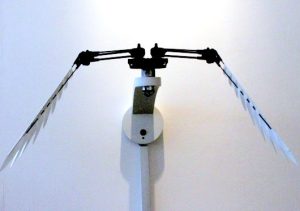
This October, Ryan Buyssens exhibited at the Kinetica Art Fair in London.
Buyssens, an Assistant Professor in UCF’s School of Visual Arts and Design, was invited to be featured among 20 artists from 10 countries. The Fair spotlights the convergence of art and technology and was called “a great example of art moving with the times” by The Times.
According to The Londonist , “The Kinetica Art Fair is comparable to the great international exhibitions of the Victorian era which combined new arts, science and technology.”
At the Fair, Buyssens’s works included his interactive sculpture resistance,. The piece is comprised of 3-D printed, laser-cut, electronic and handmade parts to create robotic wings that flap in a realistic manner. The wings begin to move when a viewer approaches, creating an experience that is simultaneously inviting and intimidating.
Associate Professor Scott F. Hall notes, “Ryan, our new Assistant Professor of Sculpture and Applied Design, is already effecting substantial, positive growth and change here in just a few months. His creative, scholarly, and often computer mediated work ranges from fine art sculpture to industrial design to animation and much more—it’s been presented in over fifty exhibitions, in U.S. patent applications, and in numerous national and international conferences.”
SVAD director Byron Clercx had this to say about resistance, “Buyssens, is a 21st century renaissance arts practitioner and educator and an artist who works with rapid prototyping technologies to create tangible interactive installations that explore, challenge, and integrate electronics, 3-D printing, product design, sculpture, digital media and video. Ryan’s adept attention to craft and human curiosity is shrewd and intentional.
“Resistance c. 2013 is an amazingly graceful mechanized gadget that is activated by a motion detector. This unpretentious aesthetic prosthetic is strangely familiar, heartwarming and life-like; while also triggering peculiar, melancholic, and detached emotions in its subjects/viewers. Buyssen’s mechanized wings graft the technological with the biological and oscilate eerily in the space between DaVinci’s uncanny drawings of, and plans for, flying machines, the Futurist’s manifestos and imagery that celebrate industry, technology, and speed; and the apocalyptic mechanized melancholy of the techno-creatures produced by Survival Research Laboratories.”